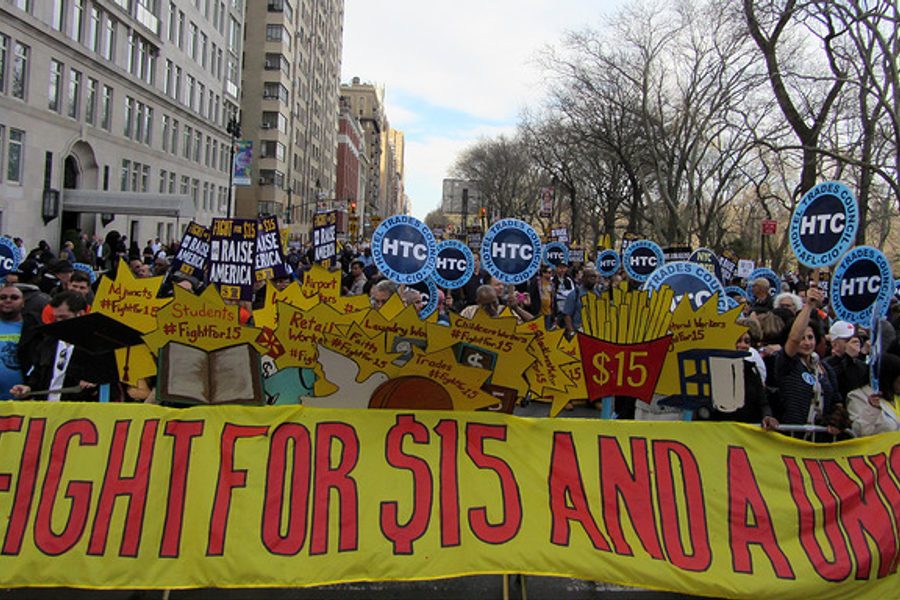
Right now, most progressives and leftists appear to be in resistance mode against Donald Trump and his administration. If his early moves are any indication, that’s exactly where they may stay. But politics is not a fixed mark, and — while we are cautious about making predictions in this utterly unpredictable political moment — one issue could emerge to court compromise: the minimum wage.
We want economic progress, and it will be tempting to look for openings in the new administration where we could push for gains for workers. We have the momentum of a movement behind us and public support remains high for raising the minimum wage. Having run on a noxiously racist, false economic populism, Trump may need to deliver something to his working-class voters. A $10 wage might seem just the ticket.
We are sympathetic to the idea that “progress” might be made here. But we have a clear message to our allies in this fight: Our side must uphold the fight for a $15 minimum wage and must reject any increase that is, as it inevitably would be under Trump, paired with concessions.
Politics is always about compromise, of course. But in this moment, we must actively resist two kinds of concessions in particular.
First, we cannot accept short-term gains in the form of a higher wage if they mean concessions that undermine our ability to organize over the long haul. Such concessions could include the ability to form unions, engage in collective bargaining, strike and protest. For example, a minimum wage increase that comes alongside cuts to the Department of Labor’s inspection staff would be a major setback. A minimum wage increase that comes at the price of “right-to-work” provisions would be disastrous.
The minimum wage is a valuable tool for raising the incomes of millions of workers, but it loses much of its value if worker organizations and movements are too weak to enforce the law. It doesn’t help people without jobs and only minimally helps those with few hours of work. Most importantly, minimum wages have the greatest impact when workers have unions to protect their jobs and help them move up to higher paid positions.
Second, we must be wary of attempts to divide our movement. The first minimum wage, which was passed in 1938, excluded domestic workers and farmworkers — occupations that were dominated by African-American workers. Today, the federal law sets a much lower minimum wage for tipped workers — a practice that disproportionately hurts women and people of color. An increase to the minimum wage must benefit everyone, including farmworkers and people who work for tips.
It’s also quite possible that a higher minimum wage could be linked to concessions on policies that impact unemployed workers, through cuts to unemployment benefits and the safety net. If we accept an increase to the minimum wage on these terms, we will drive a further wedge between the so-called “deserving” and “non-deserving” poor. Indeed, our ability to win depends on whether this fight is an inclusive one.
Of course, Trump may make no move to raise the minimum wage. But to the extent that he puts forward any gains for workers — such as the Carrier deal or putting a stop to bad trade agreements—the labor movement and its allies need to be prepared to respond.
Our job isn’t to find common ground with Trump or to figure out ways to work with a hostile administration that will put forward terrible deals. Our job is to build organizations and make our movements more powerful.
Momentum is on our side
In just four years, the movement to raise the minimum wage has experienced historic gains. Since Occupy Wall Street and the first fast food strikes, more than 40 cities and counties have set local minimum wages, with 16 reaching $15 per hour — a figure that was unimaginable five years ago. Twenty-nine states now have minimum wages above the federal level, 18 of which, along with Washington, D.C., are indexed to go up automatically with inflation. Two of those states, California and New York, will reach $15 an hour. Ten of those states have or will eliminate the sub-minimum wage for tipped workers.
Fight for $15 has been influenced by its collaboration with Black Lives Matter. In the recent national strike for $15, organizers made clear that they were fighting for $15 an hour, a union and an end to structural racism. We must stick to those demands and keep our movement united in the locally-directed, nationally-coordinated form that has helped us grow stronger thus far.
Given that legislation is only as strong as the ability of our organizations to enforce it, it makes most sense to focus on legislative victories when and where we are strongest. When we are on the defensive, passing legislation mostly means making terrible concessions that will only undermine us in the long run. For that reason, this is not a legislative moment at the federal level. It is a movement moment. Meaning, we need to put resources into movement building rather than attempting to pass national minimum wage legislation.
Life will be very difficult for workers and unions under Trump, but we cannot stop organizing. The movement to raise wages has proven to be a tool for organizing these broader movements and we should continue to do just that, keeping in mind four key points.
First, Trump and his allies are polarizing forces. We should be okay with the polarization. In a movement moment, we want to polarize, not find common ground with our enemies. If this were a legislative moment — if we were on the offense — we might ask, “Who are the moderate Republicans? Who might support our legislation?” This is not that moment. Although we have momentum on the minimum wage, we are on the defensive, overall.
Second, we can build movements around common popular demands, such as raising the minimum wage. But this isn’t enough. History shows that in times of social movement growth it is crucial to put forward radical demands. The civil rights movement didn’t just demand the end of Jim Crow, or the right to vote; it demanded jobs for all, full equality and freedom. In the 1930s, large sections of the labor movement called for the right to unionize and a minimum wage, but also worker control of the economy.
Third, we have to be clear that the Democratic Party as a whole has not been a true ally on this issue or to labor more broadly. Some Democrats support the $15 demand, but not all. Sticking with $15 helps us expose the split within the Democratic Party, calling out the corporate wing. We should push for Democrats to support the $15 federal minimum wage while we build organizations that will be able to pass that wage at state and local levels. Those organizations will be necessary to fight the attacks coming our way.
Fourth, on this issue, momentum is on our side. Poll after poll shows that voters approve of raising the minimum wage. The issue continues to win when on the ballot, even in red states. We should stay confident and bold with our demand on the federal level: A $15 minimum wage indexed to inflation, with elimination of the sub-minimum wage for tipped workers. No compromises. No concessions.
Short-term gains vs. long-term victories
It is worth noting that it is precisely because of movements that we have created a huge gap between the current federal minimum wage of $7.25 and the movement demand for $15 an hour. That means there is a massive gap for co-optation. Anything above $7.25 could be seen as a victory. If Trump pushes to raise the wage to $9 or $10, Democrats would be in the awkward position of having to oppose it.
We don’t take this position lightly, as we recognize that raising the federal minimum wage to $10 per hour would benefit millions of workers. And we don’t take this position because there is something magical about the number $15. But raising the minimum wage is only valuable alongside movements that protect and build workers’ rights more broadly.
The same logic applies to engaging with Trump on trade or infrastructure. We might agree with Trump that we do not want new trade deals. And we might agree that more money should go into building infrastructure. But we must be loud and clear that our larger vision includes trade, but trade that is fair for workers and the environment. Our vision is internationalist, not nationalist. Our vision includes building infrastructure, but infrastructure that is environmentally sustainable and provides a living wage and good, union jobs. We must maintain a vision that doesn’t accept short-term gains that cut off our capacity to do long-term organizing.
In some of the most brutal authoritarian regimes, labor unions have been the anchor of a broad working-class movement for democracy. Think South Africa, Brazil, South Korea. Our worker movements, political movements and unions must be wary of co-optation. We are not here for one-off gains for some of us. We are here to build broader movements for all of us. The minimum wage is a tool for organizing as much as it is a policy outcome. The effort to raise the wage must prioritize movement building. The “Fight for $15” is just one step in the far more important fight for democracy.




